![header=[Marker Text] body=[Scene of political and commercial activity in the colonial period, the London Coffee House opened here in 1754. It served as a place to inspect Black slaves recently arrived from Africa and to bid for their purchase at public auction. ] sign](http://explorepahistory.com/kora/files/1/10/1-A-165-139-ExplorePAHistory-a0a8o6-a_450.gif)
Mouse over for marker text
Name:
London Coffee House (American Revolution)
Region:
Philadelphia and its Countryside/Lehigh Valley
County:
Philadelphia
Marker Location:
2 S. Front St., Philadelphia
Behind the Marker
The coffeehouse was an important social and political institution in eighteenth-century Anglo-American society, as well as a de facto mercantile exchange. Often located near the docks in an Atlantic port, members of the business and maritime communities would gather here to negotiate deals, attend auctions, discuss politics, read newspapers, or grab a meal. At a time when the workshop was attached to the home, the coffeehouse was a breeding ground for both "gentility" and revolution.
Philadelphia's most fashionable establishment was the London Coffee House, located at the busy corner of Front and High Streets near the city's docks. Established in 1754 by William Bradford, a Philadelphia printer and the scion of a newspaper publishing family, the coffee house was funded, in part, by subscriptions to Bradford's Pennsylvania Journal. It quickly became the most popular and animated arena for business transactions.
Despite its name, the London Coffee House thrived on a mixed fare of caffeinated and alcoholic beverages, and simple meals. Unlike the coffeehouses of urban London, where a variety of enterprises conducted their business, the Philadelphia establishment tended to attract a more specialized crowd. Here, the owners of recently arrived schooners advertised their inventory of goods, investors bought and sold real estate and other properties, and public auctions sold off a wide variety of merchandise. Twice a week at high noon farmers from the hinterlands brought their grains and livestock to sell in the sheds across the street. Here, too, letters were held for the men who conducted their public and private transactions in the coffee house's front and back rooms.
During the late 1760s, the coffeehouses of colonial North America also became political centers. Even before the Stamp Act protests, some English conservatives derided the American coffeehouses as "seminaries of sedition." In 1765, an effigy of Massachusetts Royal Gov. Thomas Hutchinson was hanged and burned near Bradford's establishment. The London Coffee House, with an undeveloped lot next door, was also used for public meetings and outdoor auctions where Pennsylvanians bought and sold slaves from the 1750s until after the passage of Pennsylvania's gradual abolition law in 1780. By the early 1770s, however, the London Coffee House could no longer cater to the increasing business demands of a growing city. Realizing the need for larger quarters, Philadelphia's merchant aristocracy built the Merchants" Coffee House, later known as "City Tavern."
bought and sold slaves from the 1750s until after the passage of Pennsylvania's gradual abolition law in 1780. By the early 1770s, however, the London Coffee House could no longer cater to the increasing business demands of a growing city. Realizing the need for larger quarters, Philadelphia's merchant aristocracy built the Merchants" Coffee House, later known as "City Tavern."
Shuttered in the aftermath of the British occupation of Philadelphia in 1778, the London Coffee House did not re-open until 1783. But the 1780s were a difficult time in which to establish or revive a business in the city. British merchants, excluded from American markets during the war, retaliated by exporting cheap goods into the United States, while the English government prevented Americans from selling exports in the British West Indies. Unable to weather the economic hardship, the London Coffee House was in 1791 converted into a residence and general store.
Philadelphia's most fashionable establishment was the London Coffee House, located at the busy corner of Front and High Streets near the city's docks. Established in 1754 by William Bradford, a Philadelphia printer and the scion of a newspaper publishing family, the coffee house was funded, in part, by subscriptions to Bradford's Pennsylvania Journal. It quickly became the most popular and animated arena for business transactions.
Despite its name, the London Coffee House thrived on a mixed fare of caffeinated and alcoholic beverages, and simple meals. Unlike the coffeehouses of urban London, where a variety of enterprises conducted their business, the Philadelphia establishment tended to attract a more specialized crowd. Here, the owners of recently arrived schooners advertised their inventory of goods, investors bought and sold real estate and other properties, and public auctions sold off a wide variety of merchandise. Twice a week at high noon farmers from the hinterlands brought their grains and livestock to sell in the sheds across the street. Here, too, letters were held for the men who conducted their public and private transactions in the coffee house's front and back rooms.
During the late 1760s, the coffeehouses of colonial North America also became political centers. Even before the Stamp Act protests, some English conservatives derided the American coffeehouses as "seminaries of sedition." In 1765, an effigy of Massachusetts Royal Gov. Thomas Hutchinson was hanged and burned near Bradford's establishment. The London Coffee House, with an undeveloped lot next door, was also used for public meetings and outdoor auctions where Pennsylvanians
Shuttered in the aftermath of the British occupation of Philadelphia in 1778, the London Coffee House did not re-open until 1783. But the 1780s were a difficult time in which to establish or revive a business in the city. British merchants, excluded from American markets during the war, retaliated by exporting cheap goods into the United States, while the English government prevented Americans from selling exports in the British West Indies. Unable to weather the economic hardship, the London Coffee House was in 1791 converted into a residence and general store.
Beyond the Marker





